Global market dynamics are on the cusp of noteworthy transformations. The year 2024 is anticipated to be a pivotal milestone. It is characterized by industry marketplace trends swiftly embraced by numerous innovative startups.
Emerging new technologies also have an impact on the marketplace industry. The advent of OpenAI has been a critical inflection point. It compelled over 78% of brands to incorporate AI since 2020, signifying a profound shift in the paradigm. The progress of AI-enabled eCommerce will reach 15.7% CAGR by 2030.
This article explores the marketplace market, offering an exhaustive overview of insights and projections that shape the marketplace business landscape in 2024.
The Evolution of Online Marketplaces
The evolution of online shopping has been a dynamic and transformative journey, shaped by technological advancements. Each new turn is changing consumer behaviors and services offered by the industry leaders.
The growth is shaped by technological innovations, consumer preferences, and the ever-changing landscape of eCommerce business. There is more than AI to what has shaped service in digital marketplaces. So, let’s take a closer look at this article.
The Rise of Digital Commerce
The emergence of online commerce began with the internet’s commercialization in the 1990s. Websites like eBay (1995) and Amazon (1994) laid the foundation for online marketplaces. They initially focused on auction-style and book retailing, respectively.
In the early 2000s, online eCommerce business expanded beyond auctions and books to include a wide range of products and services. For example, Craigslist (1995) introduced a platform for local classifieds, while Etsy (2005) and Airbnb (2008) catered to niche markets for handmade crafts and peer-to-peer lodging.
Next, in the mid-2000s came the P2P marketplaces that facilitated direct transactions between individuals. Uber (2009) disrupted the transportation industry, introducing the concept of the sharing economy. It also started the mobile app revolution, along with
TaskRabbit (2008) in the late 2000s–early 2010s. Around that time, online marketplace platforms became increasingly specialized, catering to specific industries or interests. Platforms such as Thumbtack (2008) focused on local services, while others such as Poshmark (2011) targeted the fashion resale market.
Throughout the 2020s, the industry focused on AI and ML including People.ai, along with artificial intelligence. The major focus also is aimed at sustainability and customer-centricity with startups such as EcoCart that have just gotten a new round of financing. Their unique algorithm calculates the carbon footprint for shipping.
The pandemic in 2020 led to a boom in eCommerce revenue, drastically increasing the revenue from sales across all countries by an average of 19% in just a year. It is still possible to ride the wave in 2024 since the growth never stopped. It’s projected that by 2026, the number of online sales in retail worldwide will reach $8,148 billion, as you can see on the graph below.
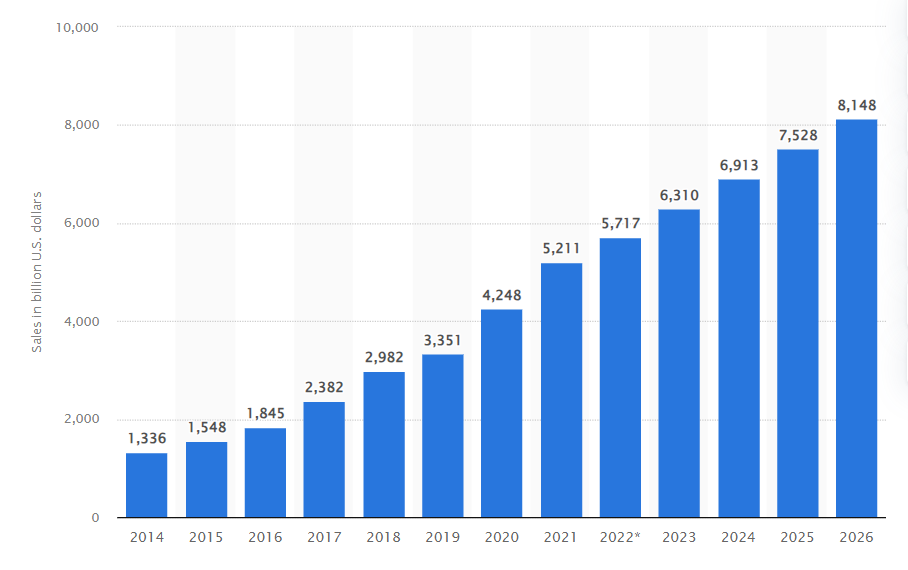

The Number of Online Sales in Retail Worldwide
The statistics show the stable growth that the retail sector has faced since 2014 ($1,336 billion), with a median indicator of a general number of online sales in retail worldwide of $5,211 billion in 2021. And in 2022, the global growth of digital sales transactions grew by 20% CAGR, reaching $5.8 trillion.
The Convergence of Online and Offline Experiences
Online sales have become more convenient for users since the pandemic times as most of the world’s popularity is used to getting their goods delivered right to their doorstep. This boosted the income of delivery services and greatly enhanced the reverence and traction of online marketplace apps.
So, in 2023, a significant portion of the US population preferred online shopping, which brought us to 43% of the whole domain of US consumers shifting their attention from their in-store habits.
The Role of Technology in Shaping the Marketplace Landscape
Technology significantly impacts marketplace development services by addressing the specific needs and challenges of the audience.
Through innovative marketing strategies, it has transformed the sector. Tech encourages users to adopt new behaviors akin to those of traditional in-store shoppers. This shift not only reflects the evolving landscape of consumer habits but also underscores the crucial role of technology in shaping modern marketplace experiences.
For example, nowadays, 18% of users find the checkout process too complicated to go further with the items purchased. The other 25% of customers don’t appreciate being induced to create an account on the marketplace.
This prompts companies to shift their attention and accommodate what users want more. Businesses are more compelled to use innovative technologies in the sales cycle to interest customers. So, customers are mostly interested in product images and reviews. This prods some companies, such as Amazon’s View in Your Room feature which lets users view items in their room using a smartphone’s camera, implement augmented reality.
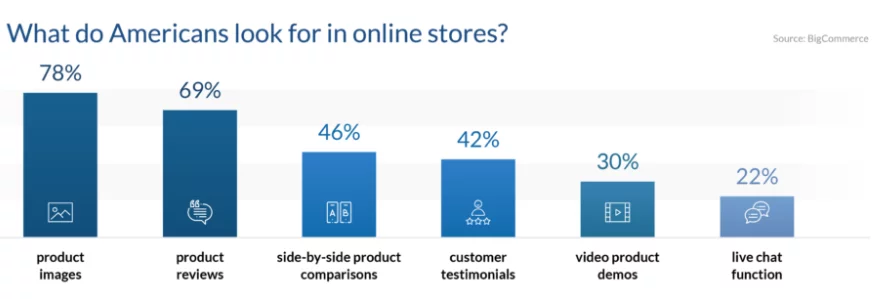

What do Americants look for in online stores?
Others, such as Alibaba company, implement artificial intelligence to ensure customers get recommended the goods they want. Overall, users generally strive for the real feel of items on sale. And innovative technology can help them try out what they’re looking for.
Let’s Discuss Your Marketplace Vision!
Contact Us
Key Trends Defining the Future of Marketplaces
As we look ahead to 2024, the landscape is shaped by a confluence of critical trends extending far beyond conventional business paradigms. These trends are poised to sculpt the marketplace niche future in profound and unprecedented ways.
So, let’s dissect the upcoming trends to gather a view of the forces that will define tomorrow’s marketplaces.
Technological Innovations and Trends in the Marketplace Industry
The eCommerce landscape prods technological innovations to become the catalysts for transformative shifts. New technologies, ideas, fresh startups, and insane competition reshape our market perception.
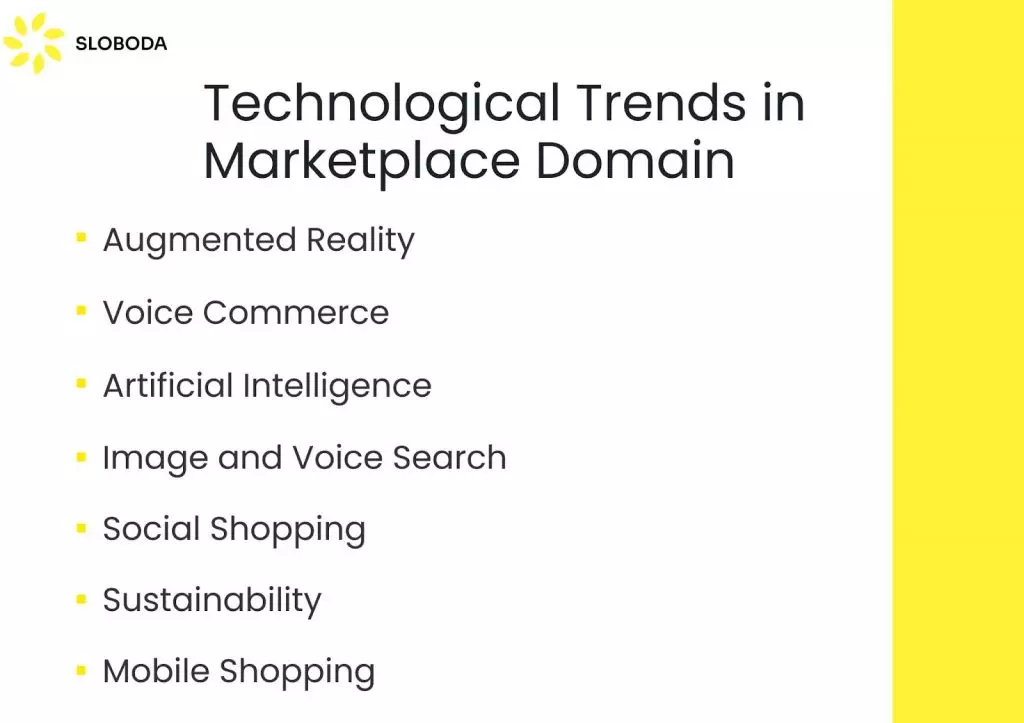

Trends in the Marketplace Domain
Nowadays, several vital technological trends emerge as game-changers, striving for enhanced consumer engagement and operational efficiency.
The Advent of Augmented Reality in Shopping
Augmented reality (AR) emerges as a formidable force in sales.
Offering customers immersive and interactive experiences, AR allows users to visualize products in actual environments before purchasing. Usually, it will imitate the product as the user opens the camera. The technology allows one to try out clothing items, fit the furniture inside one’s home, and even play with makeup.
As virtual and physical worlds seamlessly merge, businesses have unprecedented opportunities to enhance customer engagement and elevate the online purchasing journey.
AR has been discussed in the field for some time, with Sephora implementing it all the way back in 2016, paving the way for other companies to try it out, too. Wanna Kicks was next, partnering with Gucci, Nike, Adidas, and others. They allowed smartphone users to try on the sports shoes from their smartphone camera. In 2022, H&M introduced AR in their app, too, allowing people to try on garments.
2024 promises to have even more exciting ideas for AR in eCommerce. One of the most famous conferences, Awe, will hold a series of events around the world, covering social AR, the interplay between AR and AI, and many other interesting topics.
Voice Commerce: The New Frontier
Voice commerce service, also known as v-commerce or voice-activated commerce, is a voice recognition feature. It enables users to interact with these apps through spoken commands. This innovative form of eCommerce leverages the capabilities of virtual assistants and smart devices to streamline sales for customers.
Voice commerce, powered by virtual assistants and smart devices, revolutionizes how customers browse, search, and purchase products. It helps businesses gain a competitive edge, offering a more convenient and natural shopping experience.
Amazon and Shelf.ai are using voice commerce already, as it has been recognized as a highly helpful and prosperous niche. Still, this feature makes people question its security. However, it is highly profitable with a CAGR of 24.34%. To hear more about the future of voice commerce, you can check out The Next Web conference. It will brush upon voice commerce among other topics this year.
Artificial Intelligence: Beyond Chatbots
Artificial intelligence (AI) is evolving beyond its initial applications. Its reach is extending into personalized customer experiences and predictive analytics.
AI algorithms can now analyze consumer preferences, streamline recommendations, and enhance overall user satisfaction. Integrating AI-driven insights into decision-making processes positions online shopping industry to be more responsive and adaptive.
Artificial intelligence has been used in business for a long time. However, now with OpenAI and the new capabilities this technology offers, it’s being discussed anew. For example, AI Summit West will be talking about OpenAI in eCommerce. Jeff Clune – the OpenAI team lead, will be present at the discussion. In 2023 75% of IT leaders claimed that AI might help address security issues. And this has always been a pain point for eCommerce companies.
Integrate AI to your marketplace
Get a quote
Image and Voice Search Capabilities
Search functionalities are undergoing a paradigm shift with image and voice capabilities integration. Around 50% of users use voice search to look for products. The voice market and AI services are projected to grow to over $98 billion by 2028. They are used by Google, Microsoft, AWS, Walmart, and many others.
Visual and voice search technologies empower users to find products in no time by capturing an image or articulating a query.
Marketplace businesses that optimize for these capabilities tap into a more intuitive and user-friendly search experience. This approach and the technology align with the evolving preferences of tech-savvy customers. In the graph below, you can see that the prevalent age group for online shopping is people aged 25 to 34, however, younger generations steadily follow. So, it’s important to orient your business to customers who are familiar with technology.
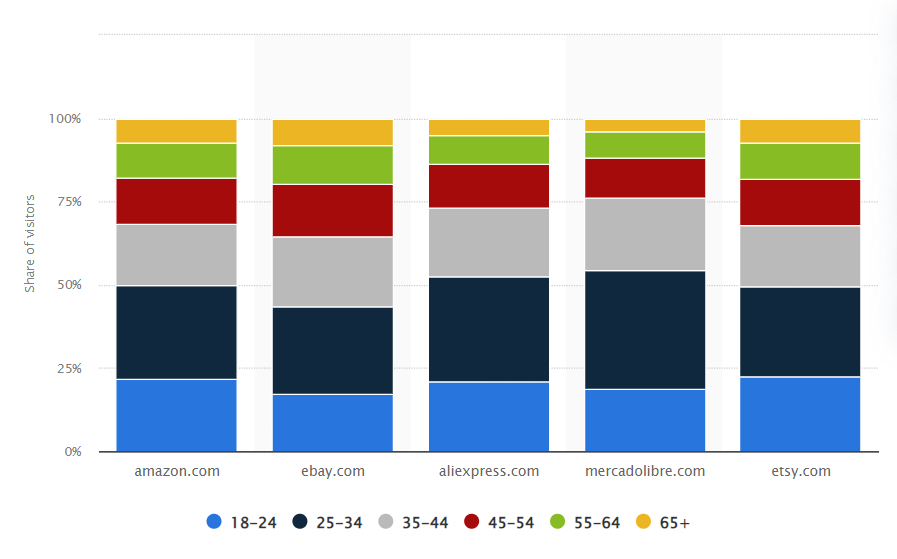

Share of Consumers on the Most Popular Marketplace Companies by Age
As we navigate the evolving landscape of eCommerce in 2024, it becomes evident that individual preferences do not solely influence the trajectory of consumer behavior. However, it is profoundly shaped by societal and environmental considerations. This exploration sheds light on three pivotal trends driving behavioral shifts in online marketplace shopping.
The traditional boundaries between social media and eCommerce are dissipating, giving rise to a phenomenon known as social shopping. Platforms such as Instagram and Facebook are integrating shopping features seamlessly into their interfaces. This approach allows users to discover, explore, and purchase products without leaving the social media environment.
For instance, Instagram’s “Shoppable Posts” enable businesses to tag products directly in their posts. It transforms the platform into a virtual storefront. Consumers can make purchase decisions influenced by the recommendations and experiences shared within their social networks. In 2023, the social commerce niche hit $1.3 trillion in total market size.
Sustainability as a Core Marketplace Value
A profound shift in consumer consciousness is steering online marketplaces toward embracing sustainability as a core value. Eco-friendly and ethically sourced products are gaining prominence. Hence, there is a growing awareness of environmental impact and responsibility.
The graph below represents the degree of change in consumers globally. It shows that customers are inclined to buy more sustainable products. It shows that the majority has a slight shift towards more sustainable behavior.
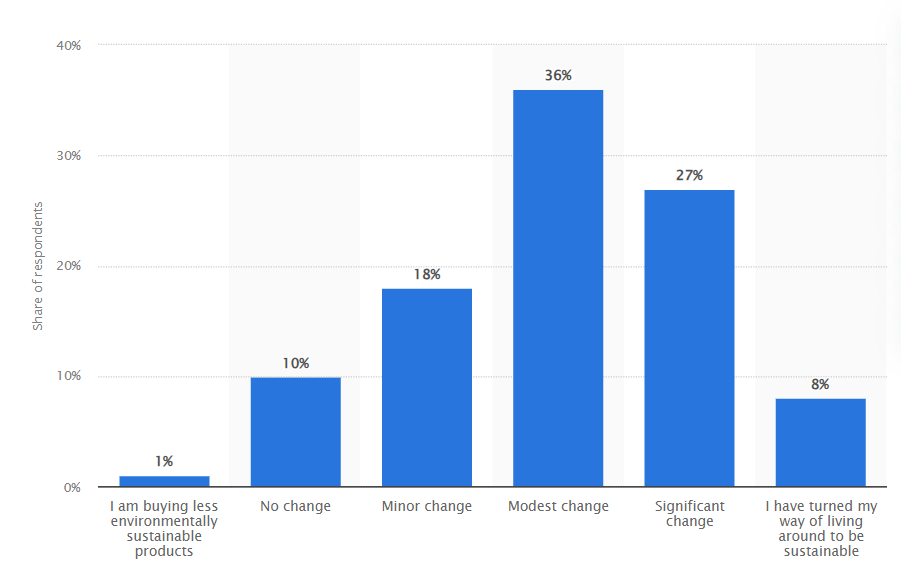

Evolution of Sustainable Shopping Worldwide
Marketplaces are responding by curating dedicated sections for sustainable goods. Platforms such as Etsy highlight products crafted from recycled materials or support fair trade practices. As a company, we also support the sustainable approach. 25% of our customers are either developing a new sustainable service or contributing to sustainability in any considerable way.
The Growing Importance of Mobile eCommerce
Mobile commerce has transcended convenience to become the heartbeat of online shopping in 2023. Nowadays, this domain’s value reaches an astonishing $2.2 trillion in 2023.
Consumers increasingly turn to their smartphones for seamless and on-the-go transactions. Apps and mobile-optimized websites are pivotal in capturing the attention of the modern shopper. One example is the popularity of mobile payment solutions such as Apple Pay and Google Pay. Users can buy items with a simple tap or scan, reducing friction in the purchasing process. Mobile eCommerce is reshaping the shopping journey. It emphasizes the need for online stores to prioritize mobile accessibility and user experience.
It becomes vital to focus on the stability of cooperating with technical partners. But, will your investments in trends be profitable when connecting with technology experts? Let’s talk about it in the next paragraph.
How to Make Cooperation With Experts in Marketplaces Successful
After working with marketplaces for over a decade, Sloboda Studio has gathered some insights regarding measuring and improving the success of working with marketplace development vendors. These aren’t metrics but rather useful tips for marketplace companies searching to connect with a technical team.
By this time, we’ve built and scaled over 20 marketplace projects with a dedicated development team. So, using this experience, we’ve concluded that:
Communication is Drastic
One of the projects we’ve worked on, Veeqo, had a complex challenge of communicational coherency. The software was built on multiple technologies, which impaired the workflow of the developers individually. This made them dependent on one another. Our team established weekly and daily meetings and agile methodology, to solve this issue. Once again, clear communication has proved to be a great tool for achieving great results.
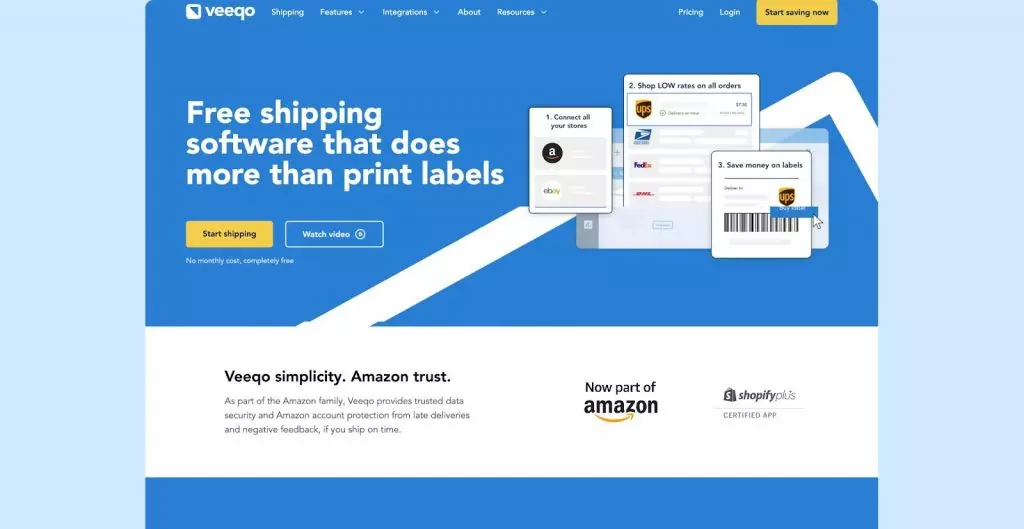

Veeqo
Don’t Blindly Follow the Trends
Throughout our work, we’ve encountered several aspiring startups that followed the same doom pattern – chasing the trends. However, it’s important to remember that trending doesn’t always mean good for your business. Your original idea will be more important to your business and customers than a trend that can hinder your workflow if not implemented correctly. A more practical example could be AI, which many companies strive to implement.
True that AI has numerous benefits, however, it also has its cons. The technology is intricate, imperfect, and expensive. So, start with automation first and then see where it takes the business. Whether there is a need for AI at all.
Trends can be broken down into smaller pieces that are easier to execute. Test if you want and need to implement a trendy feature by leveraging this approach.
Always Measure your KPIs
KPIs are your compass to success. With one of our projects, Artur’In we had a problem with KPI measuring. Since this issue is pressing and drastically important, we couldn’t just set it aside. So, we created a clean analytical tool to track it. Marketplace metrics help identify the direction your marketplace moves and make changes or even pivot along the way.
Operational and Tactical Marketplace Trends
As we peer into the near future of 2024, strategic decision-making and operational understanding will be critical for businesses to stay ahead in this competitive arena. This exploration navigates through crucial operational and tactical marketplace latest trends.
The Increasing Role of Advertising
Advertising has transcended its traditional role. Now, with the trend toward targeted and personalized marketing, it’s integral to the success of digital marketplaces. Online platforms leverage targeted marketing to enhance user experience and boost revenue streams. A prime example is Amazon. Their sponsored product listings allow sellers to prominently showcase their products to potential customers.
Marketplaces evolve into comprehensive ecosystems. Now, the strategic use of marketing facilitates product discovery and enhances revenue generation.
Diverse Payment Options: From Digital Wallets and Post-Payments to Cryptocurrencies
Payment preferences are undergoing a seismic shift. Now, marketplace businesses are adapting by offering many options beyond traditional payment methods. Digital wallets like PayPal have become ubiquitous. It is them that help businesses streamline transactions and enhance user convenience.
The rise of post-payment solutions like Afterpay and Klarna, creates flexibility in finance management. Integrating cryptocurrencies into marketplace payment systems, as seen with companies like Shopify enabling cryptocurrency payments, caters to diversifying payment options.
Acquisition Trend in Marketplace and eCommerce Industries
The marketplace and eCommerce landscape is witnessing a notable trend of acquisitions. Companies strategically expand their portfolios and capabilities. Shopify’s purchase of 6 River Systems – a robotic replenishment system that improves warehouse management – enhances its fulfillment network. Etsy invests in Depop, a social eCommerce platform. These examples tap into the burgeoning domain of second-hand fashion.
Companies bolster their technological infrastructure. It helps in diversifying product offerings and gaining a competitive edge. It highlights the importance of strategic acquisition to stay relevant in a changing marketplace environment.
Marketplace Industry Forecasts and Future Projections
As the new era begins, the marketplace sector is poised for unprecedented growth. We analyzed marketplace forecasts, and here’s what we predict will take off in 2024. The research is based on studying the projected numbers and our experience.
Predicted Growth Metrics for Online Marketplaces
The digital marketplace ecosystem is forecasted to witness remarkable growth, driven by an increasing reliance on online business platforms. In the graph below, we can follow the market cap of the most popular marketplace companies. Amazon precedes, showing that customers tend to turn to all-in-one solutions.
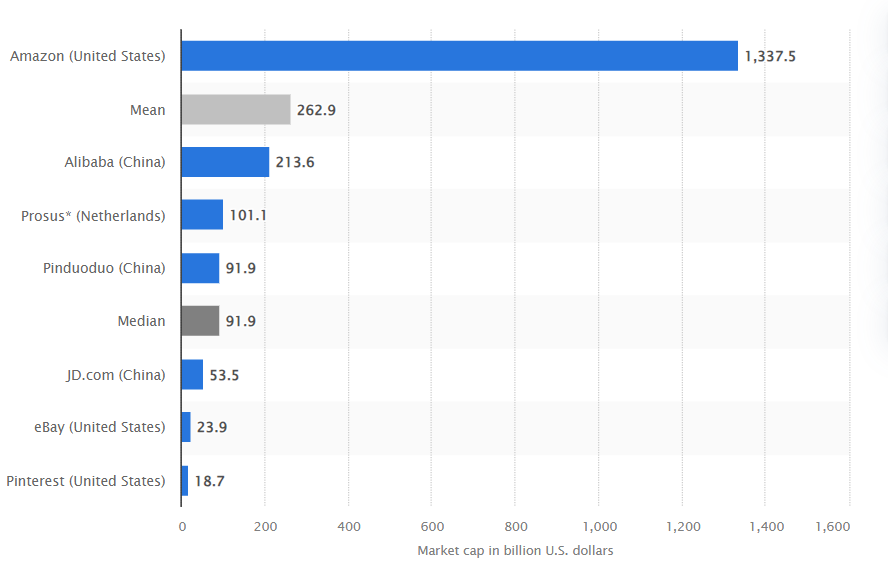

Market Cap of Leading eCommerce Companies Worldwide
B2B and service marketplaces are also expected to achieve growth over the next few years. The projected CAGR of the global B2B marketplace market reaches over 19%. The market size will cap around $36 billion by the year 2031. This implies that there is a high demand for service marketplaces, as trust grows and businesses start to offer remote shopping.
AI Potential in eCommerce Data Analysis
Artificial Intelligence (AI) is emerging as a transformative force in eCommerce, particularly in data analysis. The capability of AI algorithms to discern patterns, predict consumer behaviors, and optimize operational processes is unlocking new levels of personalization.
Amazon, for instance, utilizes AI for dynamic pricing. It ensures competitive pricing strategies instantaneously based on customers’ demand and competitor pricing. The potential of AI in data analysis extends beyond transactional insights. It encompasses personalized recommendations, fraud detection, and supply chain optimization, signaling a future where AI-driven analytics redefine the eCommerce business landscape.
Expanding Landscape of Mobile Marketplaces
The mobile-first trend is experiencing an unprecedented expansion. They are fueled by the ubiquity of smartphones and the increasing preference for on-the-go transactions. Notable examples include the growth of mobile payment platforms like Square. The popularity of mobile-focused marketplaces such as Poshmark for fashion enthusiasts also plays a role.
More seamless integrations of mobile commerce are coming into our everyday lives. Advancements like augmented reality enhance the mobile shopping experience. As customers increasingly rely on their mobile devices, this trend will continue to redefine how individuals discover, engage with, and transact on digital platforms.
Our Expert Tips for Adapting to the Changing Marketplace Landscape
We’ve been working with marketplaces since 2013. The projects we released raise millions of dollars in financing. And here are a few tips for you to take from our experience.
Implementing Strategies for Enhancing Customer Engagement
Implementing effective strategies to enhance customer engagement is a proactive measure and a strategic imperative. Utilize personalized experiences, leveraging data insights to understand customer preferences and behaviors.
You can try to implement interactive features like live chats or virtual shopping assistants to provide real-time assistance and guidance. Encourage user-generated content and foster community by engaging with customers on social media platforms. Build lasting relationships, foster brand loyalty, and stay attuned to your target audience by prioritizing customer engagement.
Leveraging Data for Informed Decision-Making
In an era dominated by data, leveraging this invaluable resource is crucial for navigating the changing marketplace landscape. This is what you can do:
- Implement robust data analytics tools, like Google Analytics, Hotjar, and Optimizely to gather insights into customer behavior, domains’ latest trends, and operational efficiency.
- Offer predictive analytics to anticipate consumer preferences and optimize inventory management.
- Employ A/B testing for marketing strategies to understand what resonates most with your audience.
By making informed choices based on data analysis, companies can stay agile and responsive. This can position you for success in the rapidly evolving marketplace. Data-driven decision-making empowers businesses to adapt quickly, identifying opportunities and mitigating risks.
Conclusion
The dynamics of the year 2024 lead us to see that innovative technologies and emerging marketplace trends te are soaring. Voice commerce, AI, and AR are joined by social media shopping and sustainability.
The marketplace audience will become more tech-savvy, which implies advanced attention to customer-centricity. Users’ behavior is changing, looking for faster, cheaper, and easier ways to complete the sale. The B2B domain is on the frontier as well, reaching new heights in CAGR and market value.
However, the latest trends should always complement your business. Before adding a new feature, try a simpler test to confirm its necessity and viability. If you need assistance, we are ready to assist. Contact us for a swift consultation to address any questions you may have.